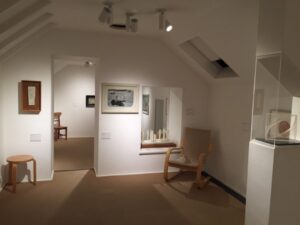Climate action examples from museums
Introduction
Climate and biodiversity action can take many forms and you don’t have to be an expert to get started. We’ve collated a small selection of examples of current climate and biodiversity work across Scotland’s museums and galleries.
Glasgow Women's Library
In 2023 Glasgow Women’s Library (GWL) launched their Net-Zero Handbook, a practical plan for building improvements which will allow them to reach operational net-zero by 2030. The team undertake regular temperature monitoring in the building allowing them to build baseline data for heat loss and energy use. They will then be able to clearly show the impact of the planned insulation and heating system improvements.
Glasgow Women’s Library is a listed building and the works are very sympathetic to that, striving to preserve heritage features such as the Landressy Street stone facade and the wood panelling f their internal walls. It is for this reason that insulation which can be ‘injected’ into the cavity whilst leaving room for the building to breathe have been chosen for these areas.
And this isn’t just work happening behind the scenes. Fundraising for the project has included “Women on the Wall”. An initiative where the public can nominate great women to have their names stencilled onto the wall, for a donation of £150 which will go directly towards the work for a sustainable, green GWL. By involving the public in the project it has continued to grow support and shown a green future to be at the heart of GWL’s ethos.
National Galleries Scotland
National Galleries of Scotland have an Environmental Response Plan (2022-2025) covering the three main areas that the arts organisation can have an impact with the Climate Emergency, Engaging and inspiring audiences, Achieving net-zero, and Adapting to protect the collection from the effects of climate change. The engagement strand has included exhibitions, short films, educational and community programming. The net-zero strand has involved route mapping with surveys, creation of business cases and investment panning as well as detailed carbon reporting and training. To ensure adaptation to future climate scenarios the National Galleries of Scotland has begun a project to create a sustainable new facility to future-proof the collection. They have also created risk assessments and work closely with relevant departments, such as Conservation, to look at the long term impact on caring for the collection.
By taking such a multi-faceted approach to the climate emergency the team at National Galleries Scotland have embedded climate work into everything they do. Engaging the public whilst working to mitigate the degree of climate change whilst being realistic about the adaptation required for the future.
Kilmartin Museum
Partnering with Nature Scot and Forestry and Land Scotland, Kilmartin Museum puts engaging people with nature at the heart of their programming. Using their Nationally Significant Prehistory collections to emphasise our species’ relationship and reliance on the land. The museum team has put together something for every audience, all ages and abilities. The priority is to feel reconnected to nature and have fun in the forest. Sparking connection to nature inspires climate action and the societal shift to valuing the natural world and our place in it.
Their Woodland Detectives programme encourages safe play and exploration of the Celtic rainforest with 3-8yr olds. This includes den building, storytelling, plant and animal ID, nature-based crafts and even tree planting and hurdle building. The group enhances the natural spaces they are in and return with friends and family to show off their work. Tours of the natural landscape and historic landmarks within it are run regularly, alongside a series of evening online talks. The museum team have also been working with a local centre for adults with learning disabilities and complex needs – supporting several members in attaining their John Muir and Archaeology Awards. The Museum team, alongside local rangers, found wheelchair accessible routes through the forests and brought pond dipping activities up to table height for some participants. This ‘nature for all’ approach has helped to create a sense of community and shared responsibility for the unique ecosystems surrounding the museum and created many new climate warriors!
For those looking for a less hands-on approach, or who are unable to visit in person, the museum’s #NatureInTheGlen Instagram series brings nature to the forefront through photography and facts in an easy to digest format. The series often focuses on the smaller, more easily missed, beauty in the outdoor world, encouraging all those who scroll upon it to take a breath and get outside.
Glenfinnan Station Museum
Spring 2025 sees Glenfinnan Station Museum open a brand new, outdoor, exhibition space. Funded by Museums Galleries Scotland, the exhibition tells the story of responses to major rail disruption caused by extreme weather and how this has changed over time. Where once heavy snow was the concern, now it is flooding and landslips. No longer needed to clear heavy snowfall it is a disused snowplough which forms the ‘building’ for the exhibition. Visitors are invited to look through the glass to the objects inside. Aside from the plough itself, the objects on display are ones which have not been on display for a long time giving the added benefit of showcasing a wider selection from the collection. By having the exhibition outside it also welcomes visitors who may not have automatically found themselves going into the museum and helps to manage the flow of visitors arriving off the train. Being harder to power as an outdoor exhibition is not an issue due to the solar panels that line the snow plough’s roof and lean-to! The lean-to was built with entirely reclaimed waste materials from the site and build by the museum’s trusty team of volunteers and gives shelter on rainy days for those viewing the exhibition.
Telling the story of climate shift and the need for adaptation within a disused tool of climate action which has re-found its purpose in climate mitigation, Glenfinnan Station Museum have taken a unique and engaging approach to climate action.
Gairloch Museum
In 2021 Gairloch Museum received MGS Capital Resilience funding to install PV (photovoltaic) panels onto their museum roof. The roof being flat, and hidden from view by a parapet, meant planning permission was relatively straight forward and after comparing quotes a company from Inverness was contracted to supply and install around 100 panels with a potential output of 50kw. Going live in March 2023 the panels immediately contributed significantly to the energy requirements of the building, and in times of low demand were able to sell back surplus energy to the grid. The team negotiated an impressive 12p per kwh sell back rate, resulting in a projected £2000 annual income. When added to the projected £4000 saving in energy costs per year the panels are helping the museum become much more financially resilient.
A display panel in the museum’s entrance allowing the team, and visitors, to see how and when the energy is being generated. Gairloch Museum is also in the early stages of planting a Gaelic Alphabet Forest – a traditional method of teaching the alphabet through nature which will aid their site’s biodiversity and audience connection with the landscape.
Perth Museum
November 2024 saw the opening of the Waters Rising exhibition at Perth Museum. The exhibition explored the cultural traditions and beliefs arising out of historic floods whist connecting them to recent floods in Perthshire and the impact on businesses, community and infrastructure. By inviting visitors to leave postcard memories of how the flooding impacted them the exhibition had a deeply personal feel, bringing the realities of climate change and increasing extreme weather events into focus and relevance to the audience. The team at Perth Museum worked with local activists, artists and community groups to not only highlight the impact of flooding but provide guidance, practical advice and inspiration for action. Resources for flood resilience can still be downloaded from their website.
It wasn’t only the content of the exhibition that focused on sustainability and the Climate Emergency however. The interpretation was printed with sustainable inks onto cardboard signage and the entirety of the exhibition build only required one new piece of MDF to be brought in, everything else was reused. At the entrance an interpretation board interrogating the carbon impact of the exhibition was on display for everyone to see and even included the carbon footprint of the emails sent throughout the exhibition’s development.
Robert Burns Birthplace Museum
Robert Burns Birthplace Museum was awarded Capital Resilience Funding from Museums Galleries Scotland for Building Sustainability and Resilience in 2024. Through this fund the museum has changed to LED lighting in their display cases as well as receiving planning permission to purchase and install solar panels in 2025. The switch to LED lighting is not only more energy efficient but also has the added benefit of allowing a higher LUX level without damaging the objects on display. This in turn has resulted in an increase in the range of objects able to be on display as well as increased accessibility to visitors. The museum has also installed a sedum roof with light tubes for the rooms below. This delivers electricity free lighting and a boost to the biodiversity of the area. The sedum roof requires minimum maintenance and is alive with pollinators, native plants and even oyster catchers, all whilst insulating the building beneath.
These estate-based interventions are a great accompaniment to the nature themes running through the interpretation of Burns’ work and the use of Scots language to bring nature to life around the museum and grounds.
Highland Folk Museum
The Highland Folk Museum joined several other museums for a webinar on composting at museum sites from Garden Organic in 2024. As part of this project the Highland Folk Museum were selected for pilot funding from Museums Galleries Scotland in partnership with Garden Organic to install a composter and interpretation at their site. After a composting suitability audit, agreement between the museum’s estates and café teams a Green Johanna composter was installed. This will not only reduce the food waste of the museum and produce rich compost for growing but also helps to engage visitors with the important processes of composting and how they have historically been used.
The Highland Folk Museum has felt the impact of extreme weather events with over 300 trees coming down in storms over recent years. They are upfront about this with visitors. The museum also has a Green Folk Staff Group who meet regularly to discuss the climate and biodiversity crises and how their museum can take action. Green Folk is made up of members of staff from across the museum’s many roles, ensuring a range of voices is heard and that all staff are empowered to contribute towards the Highland Council’s and High Life Highland’s targets for lowering carbon emissions.


